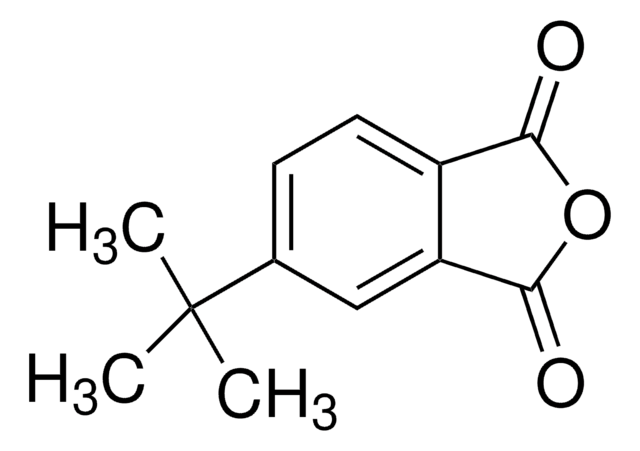149934
Hexahydro-4-methylphthalic anhydride, mixture of cis and trans
96%
Synonyme(s) :
4-Methyl-1,2-cyclohexanedicarboxylic anhydride
About This Item
Produits recommandés
Pureté
96%
Indice de réfraction
n20/D 1.477 (lit.)
Densité
1.162 g/mL at 25 °C (lit.)
Chaîne SMILES
CC1CCC2C(C1)C(=O)OC2=O
InChI
1S/C9H12O3/c1-5-2-3-6-7(4-5)9(11)12-8(6)10/h5-7H,2-4H2,1H3
Clé InChI
FKBMTBAXDISZGN-UHFFFAOYSA-N
Vous recherchez des produits similaires ? Visite Guide de comparaison des produits
Catégories apparentées
Application
- Limonene-based epoxy: Anhydride thermoset reaction study: This research explores the thermosetting reactions of limonene-based epoxy using hexahydro-4-methylphthalic anhydride, illustrating its application in creating environmentally friendly polymers (Couture et al., 2018).
- Metallocene catalysts for the ring-opening co-polymerisation of epoxides and cyclic anhydrides: Discusses the application of metallocene catalysts in ring-opening copolymerization involving hexahydro-4-methylphthalic anhydride, relevant for developing new polymeric materials (Shaw et al., 2022).
- Evaluation of Natural and Modified Castor Oil Incorporation on the Melt Processing and Physico-Chemical Properties of Polylactic Acid: Explores the use of natural oils modified with hexahydro-4-methylphthalic anhydride to enhance the properties of polylactic acid, a study significant in biodegradable plastics (Darie-Niță et al., 2022).
- Synthesis, characterization, and recycling of bio-derivable polyester covalently adaptable networks for industrial composite applications: Investigates the use of hexahydro-4-methylphthalic anhydride in creating adaptable networks for industrial applications, enhancing the sustainability of materials (Wang et al., 2024).
- Epoxidized linseed oils based networks. Case of thermal degradation: Discusses the thermal degradation of networks made from linseed oils cross-linked with hexahydro-4-methylphthalic anhydride, which is pivotal in understanding the stability and life span of bio-based polymers (Richaud et al., 2019).
Mention d'avertissement
Danger
Mentions de danger
Conseils de prudence
Classification des risques
Eye Dam. 1 - Resp. Sens. 1 - Skin Sens. 1
Code de la classe de stockage
10 - Combustible liquids
Classe de danger pour l'eau (WGK)
WGK 1
Point d'éclair (°F)
235.4 °F - closed cup
Point d'éclair (°C)
113 °C - closed cup
Équipement de protection individuelle
Eyeshields, Faceshields, Gloves, type ABEK (EN14387) respirator filter
Certificats d'analyse (COA)
Recherchez un Certificats d'analyse (COA) en saisissant le numéro de lot du produit. Les numéros de lot figurent sur l'étiquette du produit après les mots "Lot" ou "Batch".
Déjà en possession de ce produit ?
Retrouvez la documentation relative aux produits que vous avez récemment achetés dans la Bibliothèque de documents.
Les clients ont également consulté
Notre équipe de scientifiques dispose d'une expérience dans tous les secteurs de la recherche, notamment en sciences de la vie, science des matériaux, synthèse chimique, chromatographie, analyse et dans de nombreux autres domaines..
Contacter notre Service technique











